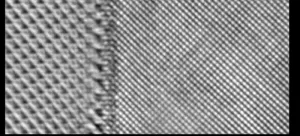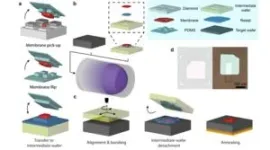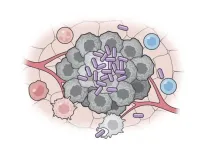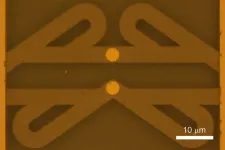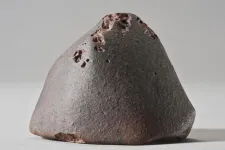(Press-News.org) Synthetic diamond is durable, inert, rigid, thermally conductive and chemically well-behaved—an elite material for both quantum and conventional electronics. But there’s one problem. Diamond only likes diamond.
It’s homoepitaxial, meaning it only grows on other diamonds, and integrating diamond into quantum or conventional computers, quantum sensors, cellphones, or other devices would mean sacrificing the diamond’s full potential or using large, expensive chunks of the precious material.
“Diamond stands alone in terms of its material properties, both for electronics—with its wide band gap, very best thermal conductivity, and exceptional dielectric strength—and for quantum technologies—it hosts nitrogen vacancy centers that are the gold standard for quantum sensing at room temperature,” said UChicago Pritzker School of Molecular Engineering (PME) Asst. Prof. Alex High. “But as a platform, it’s actually pretty terrible.”
A paper recently published in Nature Communications from UChicago PME’s High Lab and Argonne National Laboratory has solved a major hurdle facing researchers working with diamond by creating a novel way of bonding diamonds directly to materials that integrate easily with either quantum or conventional electronics.
“We make a surface treatment to the diamond and carrier substrates that makes them very attractive to each other. And by ensuring we have a pristine surface roughness, the two very flat surfaces will be bonded together,” said first author Xinghan Guo, who earned his PhD from UChicago PME in the spring. “An annealing process enhances the bond and makes it really strong. That's why our diamond can survive various nanofabrication processes. It differentiates our process from simple placement of diamond on top of another material.”
With this technique, the team directly bonded diamond with materials including silicon, fused silica, sapphire, thermal oxide, and lithium niobate without an intermediary substance to act as “glue.”
Instead of the several-hundred microns thick bulk diamonds typically used to study quantum qubits, the team bonded crystalline membranes as thin as 100 nanometers while still maintaining a spin coherence suitable for advanced quantum applications.
Perfect defects
Unlike jewelers, quantum researchers prefer a slightly flawed diamond. By precisely engineering defects in the crystal lattice, researchers create durable qubits ideal for quantum computing, quantum sensing and other applications.
“Diamond is a wide bandgap material. It's inert. In effect, it's very well-behaved and has great thermal and electronic properties,” said paper co-author F. Joseph Heremans, who has a dual appointment with UChicago PME and Argonne. “Its raw physical properties tick a lot of marks that are beneficial to a lot of different fields. It was just very difficult to integrate with dissimilar materials until now.”
However, as thin diamond membranes were previously difficult to integrate directly into devices, this required larger—but still microscopic—chunks of the material. Paper co-author Avery Linder, a UChicago Engineering fourth-year, compared building sensitive quantum devices from these diamonds to trying to make a single grilled cheese sandwich with an entire block of cheddar.
UChicago PME Asst. Prof. Peter Maurer, a co-author on the paper, works in quantum bio-sensing, using revolutionary quantum techniques to obtain better, more accurate measurements of the working of fundamental biological processes at the micro- and nanoscale.
“Although we have overcome many challenged associated with interfacing intact biological targets with diamond-based quantum sensors, their integrate into actual measurements devices, such as a commercial microscope or a diagnostic device, while not losing readout efficiency, has remained an outstanding challenge.” Maurer said. “This new work with diamond membranes bonding that Alex’s lab led has gotten around many of these issues and brings us an important step closer to applications.”
Sticky diamonds
In diamonds, each carbon atom shares electrons with four other carbon atoms. These electron-sharing bonds, called covalent bonds, create the gem’s hard, durable internal structure.
But if there is no other carbon atom nearby to share electrons, this creates what’s called “dangling bonds” on lonely atoms looking to partner. Creating a diamond surface full of these dangling bonds allowed the team to bond the nanometer-scale diamond wafers directly to other surfaces.
“You can almost think of it as like a sticky surface, because it wants to be attached to something else,” Linder said. “And so basically, what we've done is create sticky surfaces and put them together.”
The researchers have patented the process and are commercializing it through the University of Chicago’s Polsky Center for Entrepreneurship and Innovation.
“This new technique has the potential to greatly influence the ways we do quantum and even phone or computer manufacturing,” Linder said.
High compares the new diamond technique to the advances in complementary metal-oxide semiconductors (CMOS) over the years, from bulky individual transistors in labs in the 1940s to the powerful, tiny integrated circuits filling computers and phones today.
“We’re hoping that our ability to generate these thin films and integrate them in a scalable fashion can lead to something like CMOS-style revolution for diamond-based quantum technologies,” he said.
Citation: “Direct-bonded diamond membranes for heterogeneous quantum and electronic technologies,” Guo et al, Nature Communications, October 10, 2024. DOI: https://doi.org/10.1038/s41467-024-53150-3
Funding: This work was supported by the U.S. Department of Energy Office of Science National Quantum Information Science Research Centers as part of the Q-NEXT center. The membrane bonding work is supported by NSF award AM-2240399.
END
New diamond bonding technique a breakthrough for quantum devices
New technique allows greater integration of synthetic diamonds, improving how both quantum and conventional electronics are built
2024-10-16
ELSE PRESS RELEASES FROM THIS DATE:
Clean air and climate policies provide health benefits in New York City
2024-10-16
A new study analyzes the links between the enactment of major air pollution and climate policies in New York City and significant improvement in air quality during the period 1998-2021. It finds a cumulative beneficial effect of these policies both city-wide and among residents residing in communities that have been disproportionately affected by air pollution.
The study by environmental health scientists at Columbia University Mailman School of Public Health is published in the peer-reviewed journal Frontiers in Public Health.
“Because of the known significant associations between the pollutants studied and multiple adverse health effects, there are important implications for health ...
Folic acid may mitigate link between lead exposure during pregnancy and autistic behaviours in children
2024-10-16
New research gives another reason to take folic acid supplements while pregnant.
A new study by Simon Fraser University researchers has found that folate may weaken the link between blood-lead levels in pregnant women and autistic-like behaviours in their children.
Researchers from SFU’s Faculty of Health Sciences, led by PhD candidate Joshua Alampi, published the study in the journal Environmental Health Perspectives.
“Folic acid supplementation during pregnancy has numerous benefits to child health, especially brain development,” ...
MD Anderson Research Highlights for October 16, 2024
2024-10-16
HOUSTON ― The University of Texas MD Anderson Cancer Center’s Research Highlights showcases the latest breakthroughs in cancer care, research and prevention. These advances are made possible through seamless collaboration between MD Anderson’s world-leading clinicians and scientists, bringing discoveries from the lab to the clinic and back.
Novel therapeutic target overcomes treatment resistance in triple-negative breast cancer
Many patients with triple-negative breast cancer (TNBC) do not respond to combination ...
STEP Demo pilot plant achieves full operational conditions for Phase 1 of testing
2024-10-16
SAN ANTONIO — October 16, 2024 —The Supercritical Transformational Electric Power (STEP) Demo pilot plant, a $169 million, 10-megawatt supercritical carbon dioxide (sCO2) test facility at Southwest Research Institute (SwRI) in San Antonio, has completed its first phase of testing, having achieved its full operational speed of 27,000 rpm and operating at a target turbine inlet temperature of 500 degrees Celsius. As STEP achieved this milestone, it was synchronized with the electrical grid, generating approximately four megawatts of net power.
“Achieving full operating conditions while connected to the grid is a major advancement ...
Women more likely than men to die after heart surgery complications
2024-10-16
Despite having no greater chance of developing problems after high risk cardiovascular surgery, women are more likely than men to die from postoperative complications, a University of Michigan-led study suggests.
A patient dying of complications after surgery is often referred to as a “failure to rescue”.
Investigators assessed more than 850,000 cases of Medicare beneficiaries who had high risk heart surgery — including heart bypass, aortic aneurysm repair, and mitral and aortic valve repair — ...
Bacterial vaccine shows promise as cancer immunotherapy
2024-10-16
Columbia researchers have engineered probiotic bacteria that educate the immune system to destroy cancer cells, opening the door for a new class of cancer vaccines that take advantage of bacteria’s natural tumor-targeting properties. These microbial cancer vaccines can be personalized to attack each individual’s primary tumor and metastases, and may even prevent future recurrences.
In studies using mouse models of advanced colorectal cancer and melanoma, the bacterial vaccine supercharged the immune system to suppress the growth of – or in many cases eliminate – primary ...
Involuntary sweeps of homeless encampments do not improve public safety, study finds
2024-10-16
AURORA, Colo. (October 16, 2024) – A new study, out today in the Journal of Urban Health, finds that involuntary sweeps of homeless encampments in Denver, Colorado were not effective in reducing crime.
Researchers, led by first author Pranav Padmanabhan, research assistant and MPH student at the University of Colorado Anschutz Medical Campus, analyzed the effect of involuntary displacement on crime in one-quarter to three-quarters of a mile radius around sweep sites, among all sweeps between November ...
In utero exposure to maternal COVID-19 and offspring neurodevelopment through age 24 months
2024-10-16
About The Study: In this cohort study of pregnant individuals and offspring, exposure to maternal COVID-19 was not associated with abnormal neurodevelopmental screening results through 24 months’ postpartum. Continued study of diverse groups of children is needed because, among other factors, evidence suggests sensitivity of the developing fetal brain to maternal immune activation.
Corresponding Author: To contact the corresponding author, Eleni G. Jaswa, MD, MSc, MAS, email elenijaswa@gmail.com.
To access the embargoed study: Visit our For The Media website ...
Feeling the heat: a new approach to controlling heat flow in crystals
2024-10-16
Tokyo, Japan – Unwanted heating of electronic components hinders the performance of many devices. For example, the processing speed and memory available to silicon-based computer chips depend strongly on the ability to dissipate heat effectively. Unfortunately, despite high demand, thermal management remains challenging.
Now, in a study published in Nature, a team of researchers led by the Institute of Industrial Science, the University of Tokyo, has demonstrated the ability to control heat transfer in graphite crystals. Their novel approach applies concepts from fluid ...
The origin of most meteorites finally revealed
2024-10-16
An international team led by three researchers from the CNRS1, the European Southern Observatory (ESO, Europe), and Charles University (Czech Republic) has successfully demonstrated that 70% of all known meteorite falls originate from just three young asteroid families. These families were produced by three recent collisions that occurred in the main asteroid belt 5.8, 7.5, and about 40 million years ago. The team also revealed the sources of other types of meteorites; with this research, the origin of more than 90% of meteorites ...
LAST 30 PRESS RELEASES:
Ticking time bomb: Some farmers report as many as 70 tick encounters over a 6-month period
Turning garden and crop waste into plastics
Scientists discover ‘platypus galaxies’ in the early universe
Seeing thyroid cancer in a new light: when AI meets label-free imaging in the operating room
Neutrophil-to-lymphocyte ratio may aid risk stratification in depressive disorder
2026 Seismological Society of America Annual Meeting
AI-powered ECG analysis offers promising path for early detection of chronic obstructive pulmonary disease, says Mount Sinai researchers
GIMM uncovers flaws in lab-grown heart cells and paves the way for improved treatments
Cracking the evolutionary code of sleep
Medications could help the aging brain cope with surgery, memory impairment
Back pain linked to worse sleep years later in men over 65, according to study
CDC urges ‘shared decision-making’ on some childhood vaccines; many unclear about what that means
New research finds that an ‘equal treatment’ approach to economic opportunity advertising can backfire
Researchers create shape-shifting, self-navigating microparticles
Science army mobilizes to map US soil microbiome
Researchers develop new tools to turn grain crops into biosensors
Do supervised consumption sites bring increased crime? Study suggests that’s a myth
New mass spec innovation could transform research
Maternal nativity, race, and ethnicity and infant mortality in the US
Migration-related trauma among asylum seekers exposed to the migrant protection protocols
Jupiter’s moon Europa has a seafloor that may be quiet and lifeless
SwRI upgrades nuclear magnetic resonance laboratory for pharmaceutical R&D
House sparrows in northern Norway can help us save other endangered animals
Crohn's & Colitis Foundation survey reveals more than 1/3 of young adults with IBD face step therapy insurance barriers
Tethered UAV autonomous knotting on environmental structures for transport
Decentralized social media platforms unlock authentic consumer feedback
American Pediatric Society announces Vanderbilt University School of Medicine as host institution for APS Howland Visiting Professor Program
Scientists discover first method to safely back up quantum information
A role for orange pigments in birds and human redheads
Pathways to net-zero greenhouse gas emissions for Southeast Asia
[Press-News.org] New diamond bonding technique a breakthrough for quantum devicesNew technique allows greater integration of synthetic diamonds, improving how both quantum and conventional electronics are built
